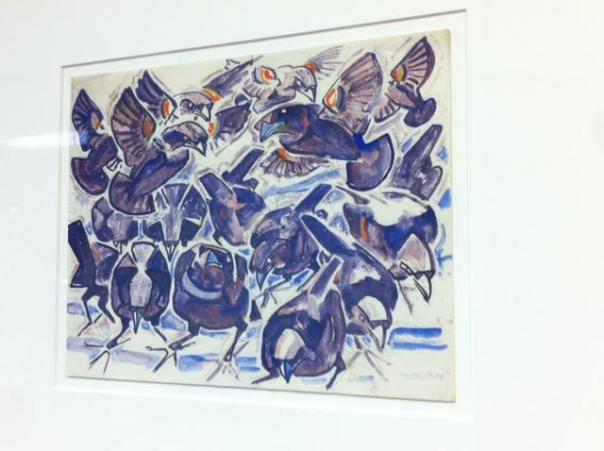More and more events have been happening with my cities Edgar Allan Poe themed Big Read. I have not attended all of the events, but have been documenting for the one’s that I have. This is the second part in a three-part blog post about The Big Read. The view the first post, just click this link; Edgar Allan Poe… Part I.

So, these blog posts probably should have gone by month, but they didn’t. This post will contain one October event and two out of three November events.

The Exquisite Dreams: Poe Illustrated exhibit was put together by the students of the Department of Art & Design, as well as the university library. The students first illustrated ravens, then moved on to illustrating one of Poe’s stories. The opening reception was on 28.October, which I attended. I also went again last night, 12.November, with The Mom & The Sister. There are photo’s from both evenings.
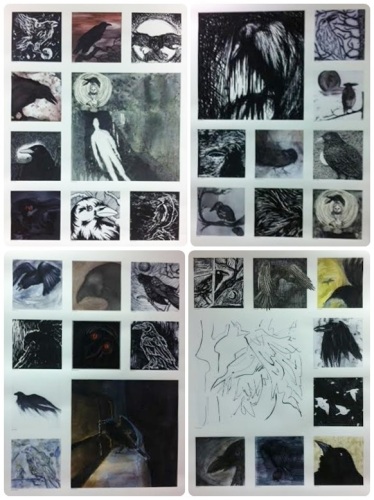


During the opening reception the professor was there to honour the students with honorable mentions up to first place, as this was apparently a competition. Personally some of the pieces that won, I was not all that impressed with; which is an opinion The Sister also expressed when she viewed them. Also the opening reception was filled with young college students who didn’t understand the concept of viewing art, as they would gather in small groups, in front of a piece, and either chit-chat animatedly, or else stare at their smart phones. On several occasions, I would have to ask them, politely, to move, so that I could actually look at a piece.
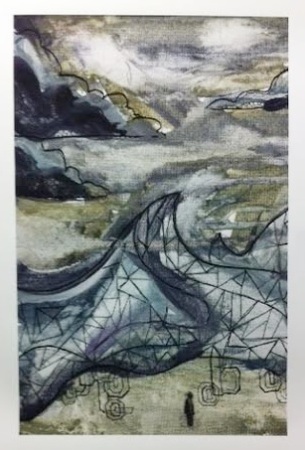









On 5. November, the local library had a film screening of the 1960 Vincent Price film, House of Usher. I attended solo. On the other occasions that I had been to media room, the lights were on and the doors open. I actually went down the ramp and up to the door. I heard no one, and trooped back up the ramp to the service desk to ask if this event was still going on. It was. It turns out they were just being spooky, by having the windows of the doors covered and the lights dimmed.
There were only nine other people there and it was freezing. One lady even got up in the middle of the film to use the Keurig machine to make coffee. As soon as it started up, every single person turned around to see what all the commotion was about. That’s a before or after the film thing, lady. Anyways. The film was enjoyable and I’m glad that I went. I dig Vincent Price and old films, but had not seen this one before.
There are two women from the university library that are heading up our cities Big Read; a brunette and a blonde. The blonde is always present at the opening receptions and the single events. I even emailed her, not knowing who she was, but because she was listed as who to contact, because The Big Read event website had a certain time for the Illustrated Poe opening, but news had spread among the university librarians and students about a different time, which I found out from The Friend, because she is in fact a university librarian, just not one in charge of things like this lady.

So, last night at the lecture, because of course she was there, she mentioned The House of Usher; commenting that at several points during the film, viewers were putting their hands up to their mouths trying not the laugh because it is so hokey. She didn’t say hokey, but a word similar that I can not recall now. I think, perhaps, that she was really just referring to herself. While she sat at the very front, and therefore could not see anyone else, I was in the back and could see everyone. No one acted like they thought the film was hokey, nor did I get that general vibe off of people. It’s actually a pretty well made film. It’s not scary, but it certainly is suspenseful. I feel that everyone was actually digging the film, wondering what would happen next. So… that was awkward Blonde Library Lady, but then I was the only one in attendance last night who was also at the film screening.
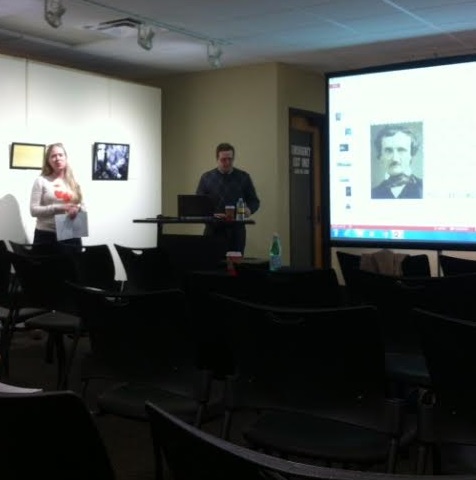
The reason I was revisiting The Illustrated Poe Exhibit, is because The Mom, The Sister and I were going to attend the lecture Poe’s America: History & Literature in the Antebellum United States. Dr. Max Grivno is a history professor at the university and specializes in pre-Civil War America.
The lecture was great, but we thought that perhaps he might bring it home better, so to speak, in personally linking Poe to all of the information more than he did. But, he might have figured that people already knew enough about Poe’s time in Baltimore, so skipped out on the personal connections?
He was, however, showing how life in Baltimore would have effected Poe’s writings, and he did that well. To recap and not be too winded. Between the 1780s & the 18-teens, Baltimore was just a tiny mill town basically. But because of war and feeding the troops they started seeing a boon in the economy and started growing larger. However, the period between 1819 and the 1840s saw a huge fluctuation in flush income and poverty. Low numbers in the alms house (where poor people worked because they couldn’t pay their bills) and the giant spikes in those numbers, and just repeat that process five or six times.
One reason was because the wars ended (The Revolutionary and then later 1812) and the people who thought things couldn’t drop, ended up bankrupted. Then later, steps in Andrew Jackson, War of 1812 hero, and by then the seventh president of the United States. President Jackson was advised to shut down the Second National Bank, a reserved bank, even though the National Bank was hurting. He did so, and placed the funds withdrawn into what was known as “Pet Banks.” and a major one was The Bank of Maryland. In doing this, bank managers were lending out entirely too much money in loans with not enough funds to back them. There were runs on the banks. There were riots. Andrew Jackson was even demonized, as was popular during that time.
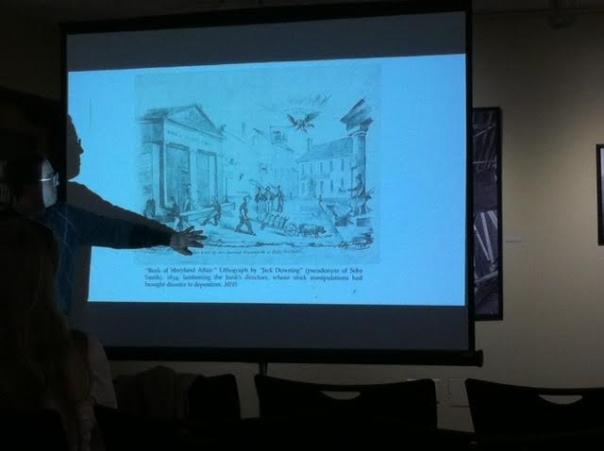
Slavery is prevalent in Maryland up until the 18-teens. Tobacco had depleted the land, because early farmers didn’t understand about crop rotations and fallow land, so they switched the wheat. Wheat needed less slaves to grow and harvest, so Marylanders ended up freeing a lot of their enslaved peoples. Those people moved to Baltimore. Slave trade was still a lucrative business in Baltimore, especially during all of those incidents of harsh economic swing. However, there was a relatively large number of Free Blacks living in Baltimore as the years got on and it was the hub of anti-slavery and abolitionist movements during that era in the entire United States.
The Professor also discussed how novelists of the time were writing romanticized novels about the formative years of the United States; the frontier, the Revolution, as well as consequential lesson themes where the protagonist does something immoral such as drinking or fornicating and therefor dies in the end. However Poe was incorporating what he saw in other ways. Instead of the vices of the day leading to death as a way to teach the reader about life lessons, or themes centering around religion, or the romanticizations of the near past; he was using what he saw in his every day life, in Baltimore, in a more thought-provoking manner. He was turning events into scenarios that wouldn’t be written about for at least fifty more years. Themes of mental illness, mind altering life patterns, and undocumented disorders.
While Poe remained in the past, his work was far into the future. His writing would go onto influence future authors, such as Jules Verne, and have such a common and wide-spread theme that his works are still relevant today, probably more-so than during his life.
The Professor is a native of Maryland, enjoyed living in Baltimore in this twenties, and is a fan of Poe. You could see this in his talk, though it wasn’t biased. It was also adorable that his go to word was “Right.” It threw that in probably fifty times during the lecture; to end or begin a sentence or just in the middle of one somewhere.
The lecture was held in the university library’s art gallery, so I snapped a photo of two pieces before the lecture got under way.

